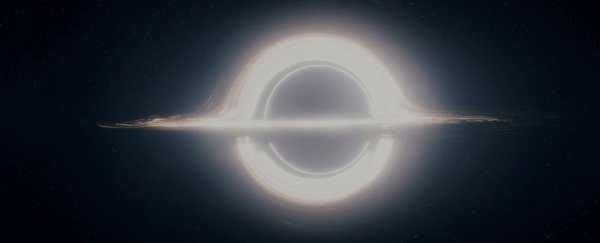In the 1970s, physicist Stephen Hawking envisioned a strange radiation shining from the boundaries of black holes, meaning they aren't quite as dark as we might think.
It's a nice idea, but to date there have been no confirmed observations of such an eerie glow. Physicists now suggest we might need to just catch the black holes at the right time - right after they smash together in a cataclysmic collision.
Hawking radiation is the natural consequence of the seething of emptiness butting up against the edge of a deep, deep chasm.
The energy of a perfect vacuum isn't quite zero. Particles can spontaneously emerge from this nothingness in pairs, colliding with one another and then blinking out of existence as quickly as they enter.
Against the edge of a black hole, it's thought one of those two particles might find itself on the wrong side of the fence, vanishing into the hole to leave its buddy to ride free into the sunset.
As you might expect, this phenomenon wouldn't exactly result in a blinding light show. Thanks to the warping of space under extreme gravity, the rare photons produced this way would also be pulled into long wavelengths, making them hard to detect.
What's worse, the black holes don't technically emit the photons – they randomly pick off virtual particles that happen to emerge nearby. That means the light doesn't have any particular set of characteristics that scream 'I was made in a black hole'.
Looking for a handful of nondescript, long-wavelength photons amid the electromagnetic chaos raining down from the sky puts Hawking radiation in the category of a needle-in-a-haystack-of-needles.
So for the time being, Hawking radiation remains just one of those many nice ideas in physics waiting to be supported or killed by facts.
A small team of researchers from Australia and Canada now propose a rather out-there method for detecting the faint signals of this hypothetical type of radiation.
They suggest searching for the light's unique signature as the photons fizz out of the gravitational waves produced by merging black holes, especially as their newly-fused body 'rings' down.
In the second before orbiting black holes finally crash into one another, they release a phenomenal amount of energy in the form of gravitational waves.
How much? Picture all of the light pouring from every star in the Universe. Multiply it by ten. Now you're getting close.
In all of that pulling and tugging of space, there should be sufficient energy to spontaneously produce far more photons out of nothingness than usual.
It still wouldn't exactly be a blinding light show, but the nature of these particular gravitational wave photons would make them stand out better against the noise.
Unfortunately, the mathematics of general relativity behind the circling of black holes as they approach their demise isn't for the faint-hearted. That's why the researchers focussed on the simpler computations of a merged black hole's short-lived pulse.
The downside is the oscillations of a black hole's 'ringing' as it calms down lasts maybe a few milliseconds, barely enough time to pop off a few photons. If you're lucky.
Ok, so it's not a perfect solution. But it is an exciting concept, especially given the progress in recent years in detecting and measuring the space-bending properties of crashing black holes and colliding neutron stars.
In time, better calculations might fine tune the idea so we can look for these light signatures amid the thunderclap of a black-hole merger.
Observing Hawking radiation wouldn't be unlike confirming gravitational waves; both being solid predictions made by famous theoretical physicists, just waiting for the perfect combination of technology and mathematics to detect.
Watch this space!
This research was published in Physical Review D.
